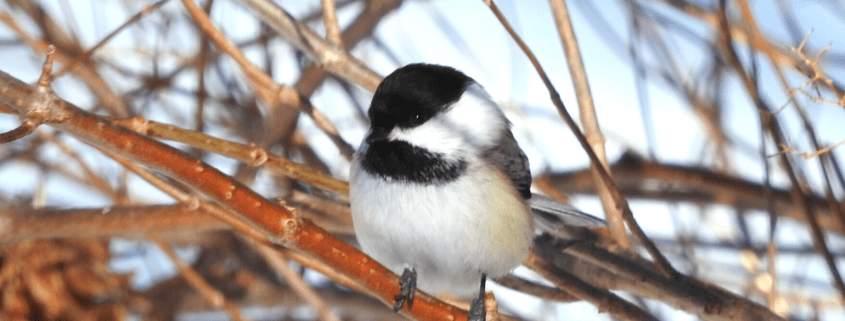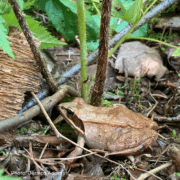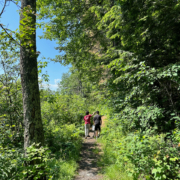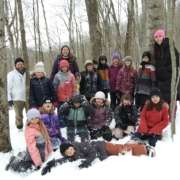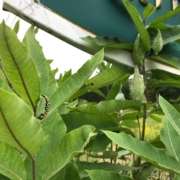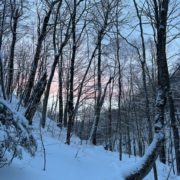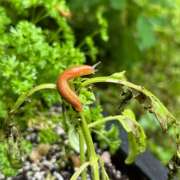Should I Stay or Should I Go? Birds and Québec Winters
Written by Jessica Adams (Nature Nerding)
Winter in Québec can be a tough season for humans. Whether we have chosen to live here or found ourselves here due to circumstances beyond our control, the shorter days, the snow and the cold get to us all at some point. Thankfully, these factors rarely pose a problem when it comes to ensuring our basic needs are met. When necessary, we can seek refuge in our homes and we can replenish our food by simply popping over to the grocery store. While thriving may seem challenging at times, surviving winter is rarely a legitimate concern thanks to the luxuries many of us enjoy.
Wildlife species, of course, do not enjoy the same comforts as humans and therefore plants, animals and fungi rely on strategies (also known as adaptations) to help ensure their survival until the next reproductive season. Birds constitute one group of wildlife that employs a wide variety of fascinating strategies to withstand our harsh winters. Some migrate long distances, others go just far enough to overwinter more comfortably, a fair few stay put and endure, and some deliberately migrate to our region for the wintertime.
Surprisingly, many birds can withstand colder temperatures – even the seemingly fragile hummingbird! So why opt for one of the abovementioned strategies over another? As it happens, it is not so much a question of braving the temperatures as it is maintaining sufficient energy to keep warm despite the cold. Energy is the most important currency in the natural world. Consuming food is energy earned and going about daily activities – such as foraging and flying – is energy spent. Much like we budget money, wild animals budget their energy and staying “out of the red”, so to speak, increases the odds of survival.
In the winter, the constant need to stay warm dramatically impacts wild animals’ energy budget. As such, bird species whose food sources are not as readily available come winter, if at all, will struggle to survive unless they find ways to compensate for this lack of resources such as changing diet or migrating to more bountiful territories. This explains why the array of bird species we can observe in the forest or at the bird feeder changes from season to season.
So who goes where and why? Here are four species you might recognize that illustrate just how beautifully diverse the bird world is when it comes to adaptations to their environment:
 Ruby-Throated Hummingbird
Ruby-Throated Hummingbird
(Colibri à gorge rubis)
Archilochus colubris
Despite their tiny size, Ruby-Throated Hummingbirds embark on an epic yearly voyage to overwinter in Central America making them long-distance migrants. Dependent on nectar from flowers and occasionally supplementing this diet with small insects, they find themselves with fewer and fewer options as fall creeps in. So while hummingbirds can indeed survive colder temperatures (within reason) they are limited in their ability to consume sufficient resources to compensate for the energy loss involved in keeping warm.
 American Robin
American Robin
(Merle d’Amérique)
Turdus migratorius
American Robins, birds we often associate with the arrival of spring, are considered residents or short-distance migrants. Some may assume that they pick up and leave for the South like many other passerines, however, their seasonal movements actually depend on food availability and any environmental conditions that may affect their ability to forage.
In the summer, Robins dine on insects and other invertebrates as well as a variety of fruits such as chokecherries, dogwood and juniper berries. Come the colder months, when invertebrates are scarce, they have been known to either migrate a short distance in search of more resources or stick around if there are enough berries available in their winter territory. Contrary to species that migrate a more considerable distance, Robins will move just far enough to seek out more ample resources and they do not necessarily follow a direct route, but instead meander from one place to another in search of fruits. Their movements can also be nudged along by weather conditions that make foraging for fruits too difficult, such as a snowstorm.
 Black-Capped Chickadee
Black-Capped Chickadee
(Mésange à tête noire)
Poecile atricapillus
Black-Capped Chickadees grace us with their amiable presence year-round and are therefore considered residents. Resident bird species are generally well-equipped to get through winter and the humble chickadee has some of the most interesting adaptations to help it survive.
In terms of ensuring enough energy intake, chickadees will shift their diet and foraging style. In summer their diet consists of 80-90% insects and this drops down to about 50% come winter when things like berries and seeds are more readily available. Furthermore, by foraging with other birds, they increase their odds of finding resources because they cover more ground and each communicates with the flock when it comes across a food source. Individuals will also set themselves up with reserves they can rely on when other food sources are in short supply. In the fall, chickadees are hard at work stashing food throughout their range. They tuck hundreds of seeds in holes in trees, under flaps of bark and in all kinds of other nooks with the intention of returning to these locations as needed. They remember where they hid everything thanks to a fascinating physiological adaptation. Every fall, the part of the chickadee’s brain responsible for spatial memory grows by approximately 30% to help the bird recall where it stashed food. The miracle of nature at its finest.
In addition to securing enough food, limiting the energy spent on keeping warm is equally important to chickadees’ survival strategy. When it comes to managing the cold, chickadees regularly fluff up their feathers, increasing the layer of insulation around their bodies and helping them maintain their core temperature (while looking adorably plump). On particularly cold nights, they find somewhere sheltered to roost and will enter a state of regulated hypothermia, dropping their body temperatures drastically (by about 9°C) so the overnight rate of heat loss (and energy consumption) is reduced. Otherwise, they rely on shivering to keep them warm, but this can be so intense that they use up most of their fat reserves and need to replenish them the next day.
 Common Redpoll
Common Redpoll
(Sizerin flammé)
Acanthis flammea
Depending on population growth and food ability, Common Redpolls will find themselves in our neck of the woods in winter (or further south) and for this reason, they are considered irruptive migrants. Similar to Robins, they adjust their winter movements from one year to the next according to food availability. Redpolls call the arctic tundra and boreal forest home, but if they experience a population increase one season followed by a shortage in food in the next, they will migrate further south. This seems to happen approximately every two years. While spending the winter in our region, they’ll forage birch and alder seeds and are known to visit birdfeeders where millet, thistle and nyjer seeds are available.
Hailing from a much harsher environment, Redpolls are no strangers to cold, however, they have evolved adaptations to help them cope with extremes. To reduce the amount of time spent exposed to the elements as they forage, Redpolls make use of a pouch in their throat (diverticula) to store seeds until they can move to a more sheltered area to feed. This maximizes their ability to gather seeds under strenuous (and energy-depleting) conditions. When particularly frigid nights are in the forecast, Redpolls exploit the insulating quality of snow and will – believe it or not – break through the snow using their heads and then tunnel a foot or so further and spend the night snow roosting. This is an effective strategy that is also used by the likes of the Ruffed Grouse.
Stepping into January means something different for everyone. Whether you love, despise or simply tolerate the winter, turning to the natural world can provide a welcome (and sometimes much-needed) shift in perspective. The above-mentioned species are just a handful of examples of all the magic at work and taking the time to be curious and pay attention to your surroundings will almost always inspire joy and wonder. On that note, no matter your winter disposition, I leave you with some invitations:
When you snuggle up in your warm bed at night, have a thought for the Common Redpoll who may very well be sleeping under the snow or the Black-Capped Chickadee, feathers ruffled, slowly slipping into a state of regulated hypothermia
When you can’t find what you’re looking for at the grocery store and have to try somewhere else, think of the American Robin needing to travel hundreds of miles if suddenly there aren’t enough fruits available
When it feels like winter will never end, remember the Ruby-Throated Hummingbird who, without fail, will be back next spring, right along with the flowers and warm sunshine
And just let yourself say “Wow.”
| Build Your Nature Vocabulary Use the text and search the web to build your nature vocabulary and try using it the next time you’re out and about in nature, either making observations by yourself or with friends!
References
|

